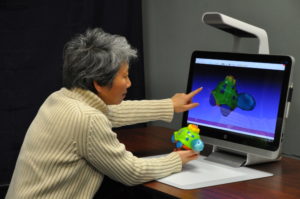AREA: Tell us about VanGogh Imaging and how the company started.
KEN LEE: The reason I started VanGogh was I noticed an opportunity in the market. From 2005 to 2008, I worked in medical imaging where we mainly used 3D models and would rarely go back to 2D images. 3D gives you so much more information and a much better visual experience than flat 2D images. But creating 3D content was a very difficult and lengthy process. This is the one huge problem that we are solving at VanGogh Imaging.
We started when Microsoft Kinect first introduced their low-cost 3D sensoring technology. It allowed you to map in a three-dimensional way, where you can see objects and scenes and capture and track them. Van Gogh started in this field around 2011 and we’ve been steadily improving our 3D capture technology for over five years, working with several clients and differentiating ourselves by delivering the highest quality and easiest way to capture 3D models.
AREA: What is Dynamic SLAM and how does it differ from standard SLAM?
KEN LEE: Standard SLAM has been around for years. It works well when the environment is fairly static – no movements, a steady environment, no lighting changes. Dynamic SLAM is a SLAM that can adjust to these factors, from moving objects and changing scenes to people walking in front and lots of occlusions.
AREA: Are there certain use cases or applications that are particularly suited to dynamic SLAM?
KEN LEE: Dynamic SLAM is perfect for the real world, real-time environment. In our case, we are using dynamic capture mostly to enhance the 3D capture capability – so making 3D capture much easier, but still capturing at a 3D photorealistic level and fully automating the entire capture process plus dealing with any changes.
Let’s say you’re capturing a changing scene. You can update the 3D models in real time, just as you would capture 2D images with a video camera. We can do the same thing, but every output will be an updated 3D model at that given point. That’s why Dynamic SLAM is great. You can use dynamic SLAM just for tracking – for AR and VR – but that’s just one aspect. Our focus is on having the best tracking, not just for tracking purposes, but really to use that tracking capability to capture models very easily and update them in real time.
AREA: Once you have that model, can you use it for any number of different processes and applications?
KEN LEE: Sure. For example, you can do something as basic as creating 3D content to show people remotely. Let’s say I have a product on my desk and I want to show it to you. I can take a picture of it, or in less than a minute, I can scan that product, email it, and you immediately get a 3D model. Microsoft is updating its PowerPoint software next year so you will be able to embed 3D models.
There are other applications. You can use the 3D model for 3D printing. You can also use it for AR and VR, enabling users to visualize objects as true 3D models. One of the biggest challenges in both the VR and AR industry is content generation. It is very difficult to generate true 3D content in a fully automated process, on a real-time basis, that enables you to interact with other people using that same 3D model! That’s the massive problem we’re solving. We’re constantly working on scene capture, which we want to showcase this year, using the same Dynamic SLAM technology. Once you have that, anyone anywhere can instantly generate a 3D model. It’s almost as easy as generating a 2D image.
AREA: Does it require a lot of training to learn how to do the 3D capture?
KEN LEE: Absolutely not. You just grab the object in your hand, rotate it around and make sure all the views are okay, press the button, and then boom, you’ve got a fully-textured high-resolution 3D model. It takes less than a minute. You can teach a five-year-old to do it.
AREA: Tell us about your sales model. You are selling to companies that are embedding the technology in their products, but are you also selling directly to companies and users?
KEN LEE: Our business model is a licensing model, so we license our SDK on a per-unit basis. We want to stay with that. We want to stay as a core technology company for the time being. We don’t have any immediate plan for our own products.
AREA: Without giving away any trade secrets, what’s next in the product pipeline for VanGogh imaging?
KEN LEE: We just filed a patent on how to stream 3D models to remote areas in real time. Basically, we’ll be able to immediately capture any object or scene, as soon as you turn on the camera, as a true 3D model streaming in real time, through a low bandwidth wireless data network.
AREA: Do you have any advice for companies that are just getting into augmented reality and looking at their options?
KEN LEE: At this moment, Augmented Reality platforms are still immature. I would recommend that companies focus, not on technology, but on solving industry problems. What are the problems that the companies are facing and where could AR add unique value? Right now, the biggest challenge in the AR industry, and the reason why it hasn’t taken off yet, is that so much money has gone into building platforms, but no one has built real solutions for companies. I think they should look for opportunity in those spaces.

